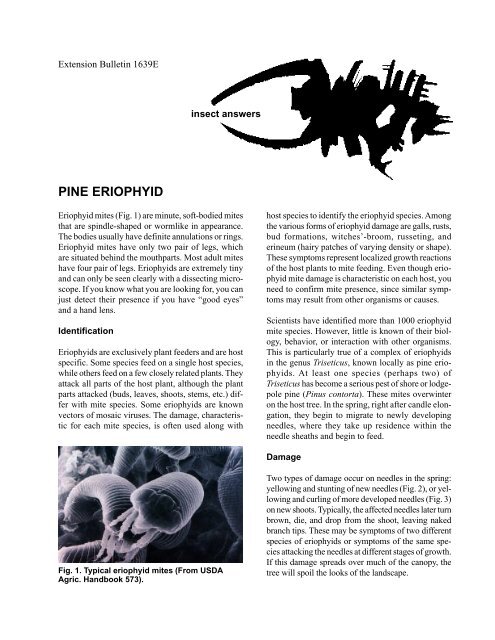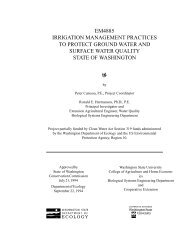PINE ERIOPHYID - Washington State University
PINE ERIOPHYID - Washington State University
PINE ERIOPHYID - Washington State University
You also want an ePaper? Increase the reach of your titles
YUMPU automatically turns print PDFs into web optimized ePapers that Google loves.
Extension Bulletin 1639E<br />
<strong>PINE</strong> <strong>ERIOPHYID</strong><br />
insect answers<br />
Eriophyid mites (Fig. 1) are minute, soft-bodied mites<br />
that are spindle-shaped or wormlike in appearance.<br />
The bodies usually have definite annulations or rings.<br />
Eriophyid mites have only two pair of legs, which<br />
are situated behind the mouthparts. Most adult mites<br />
have four pair of legs. Eriophyids are extremely tiny<br />
and can only be seen clearly with a dissecting microscope.<br />
If you know what you are looking for, you can<br />
just detect their presence if you have “good eyes”<br />
and a hand lens.<br />
Identification<br />
Eriophyids are exclusively plant feeders and are host<br />
specific. Some species feed on a single host species,<br />
while others feed on a few closely related plants. They<br />
attack all parts of the host plant, although the plant<br />
parts attacked (buds, leaves, shoots, stems, etc.) differ<br />
with mite species. Some eriophyids are known<br />
vectors of mosaic viruses. The damage, characteristic<br />
for each mite species, is often used along with<br />
Fig. 1. Typical eriophyid mites (From USDA<br />
Agric. Handbook 573).<br />
host species to identify the eriophyid species. Among<br />
the various forms of eriophyid damage are galls, rusts,<br />
bud formations, witches’-broom, russeting, and<br />
erineum (hairy patches of varying density or shape).<br />
These symptoms represent localized growth reactions<br />
of the host plants to mite feeding. Even though eriophyid<br />
mite damage is characteristic on each host, you<br />
need to confirm mite presence, since similar symptoms<br />
may result from other organisms or causes.<br />
Scientists have identified more than 1000 eriophyid<br />
mite species. However, little is known of their biology,<br />
behavior, or interaction with other organisms.<br />
This is particularly true of a complex of eriophyids<br />
in the genus Triseticus, known locally as pine eriophyids.<br />
At least one species (perhaps two) of<br />
Triseticus has become a serious pest of shore or lodgepole<br />
pine (Pinus contorta). These mites overwinter<br />
on the host tree. In the spring, right after candle elongation,<br />
they begin to migrate to newly developing<br />
needles, where they take up residence within the<br />
needle sheaths and begin to feed.<br />
Damage<br />
Two types of damage occur on needles in the spring:<br />
yellowing and stunting of new needles (Fig. 2), or yellowing<br />
and curling of more developed needles (Fig. 3)<br />
on new shoots. Typically, the affected needles later turn<br />
brown, die, and drop from the shoot, leaving naked<br />
branch tips. These may be symptoms of two different<br />
species of eriophyids or symptoms of the same species<br />
attacking the needles at different stages of growth.<br />
If this damage spreads over much of the canopy, the<br />
tree will spoil the looks of the landscape.
Fig. 2. Eriophyid mite damage to shore pine<br />
needles early in needle development.<br />
Control<br />
Properly timed chemical sprays will satisfactorily<br />
control these mites. Begin control measures when new<br />
candles (Fig. 4) are fully elongated, and new needles<br />
are 1 /2 to 1 inch long. Make at least two applications<br />
7 days apart. Sevin is the preferred material. Sevin<br />
will not perform well without adding 0.5% Superior<br />
oil to the insecticide/water mix.<br />
Commercial applicators. Use 1 pound active ingredient<br />
(carbaryl) plus 64 ounces Superior oil in 100<br />
gallons of water.<br />
Homeowners. Use labels for Sevin registered for<br />
trees or ornamentals. Add 3.5 teaspoons of Superior<br />
oil to the amount of insecticide for each gallon of<br />
water.<br />
NOTE: Do not apply Sevin (carbaryl) where it may<br />
drift onto blooming shrubs, flowers, or weeds, including<br />
lawn weeds. Cover blooming plants and mow off<br />
weed flowers a day or two prior to application. This<br />
material is extremely toxic to foraging bees.<br />
Fig. 3. Damage on more fully developed needles.<br />
Note: damage is on bottom twig. Top twig is<br />
healthy, uninfested. (Byther photo)<br />
Fig. 4. Approximate stage of candle and needle<br />
development when first application should be<br />
made.<br />
By Arthur L. Antonelli, Extension entomologist, <strong>Washington</strong> <strong>State</strong> <strong>University</strong> Puyallup Research and Extension Center.<br />
Use pesticides with care. Apply them only to plants, animals. or sites listed on the label. When mixing and applying pesticides, follow all<br />
label precautions to protect yourself and others around you. It is a violation of the law to disregard label directions. If pesticides are<br />
spilled on skin or clothing, remove clothing and wash skin thoroughly. Store pesticides in their original containers and keep them out of<br />
the reach of children, pets, and livestock.<br />
Issued by <strong>Washington</strong> <strong>State</strong> Cooperative and the U.S. Department of Agriculture in furtherance of the Acts of May 8, and June 30, 1914.<br />
Cooperative Extension programs and policies are consistent with federal and state laws and regulations on nondiscrimination regarding<br />
race, sex, religion, age, color, creed, national or ethnic origin; physical, mental or sensory disability; marital status, sexual orientation,<br />
and status as a Vietnam-era or disabled veteran. Evidence of noncompliance may be reported through your local Cooperative Extension<br />
office. Trade names have been used to simplify information; no endorsement is intended. Published February 1992. Revised March 2003.<br />
Subject code 352.<br />
EB1639E

















